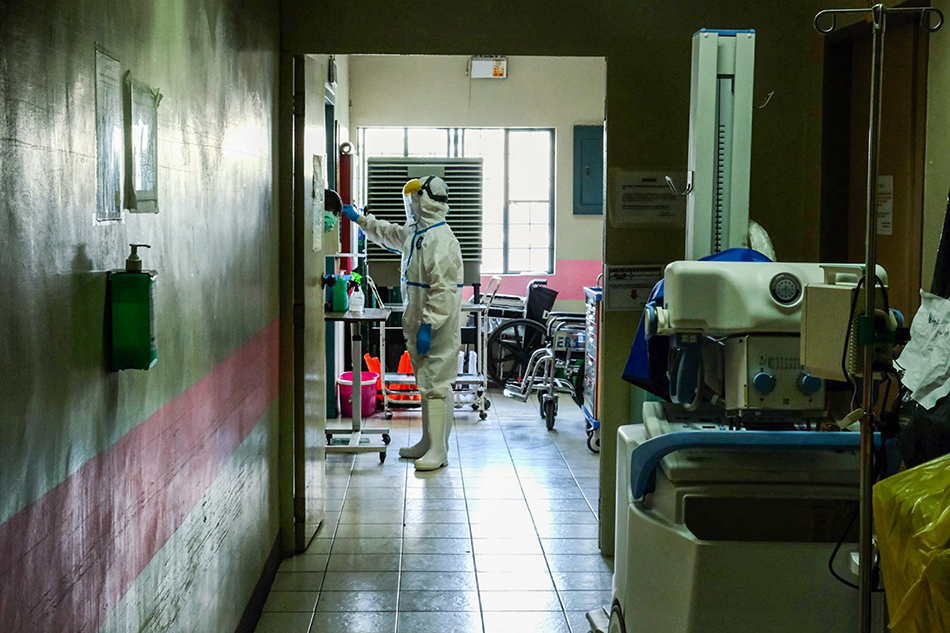DOH: ICU, ward beds in NCR, Region 4 in ‘danger zone’ as COVID-19 cases continue to surge
ADVERTISEMENT

Welcome, Kapamilya! We use cookies to improve your browsing experience. Continuing to use this site means you agree to our use of cookies. Tell me more!
DOH: ICU, ward beds in NCR, Region 4 in ‘danger zone’ as COVID-19 cases continue to surge
Kristine Sabillo,
ABS-CBN News
Published Jul 28, 2020 09:28 PM PHT
|
Updated Jul 28, 2020 09:51 PM PHT
MANILA — The Department of Health on Tuesday said that COVID-19 hospital bed occupancy in the National Capital Region and Region IV-A or Calabarzon has reached the “danger zone” or more than 70% occupancy.
MANILA — The Department of Health on Tuesday said that COVID-19 hospital bed occupancy in the National Capital Region and Region IV-A or Calabarzon has reached the “danger zone” or more than 70% occupancy.
“Manageable pa po ang national bed and mechanical ventilator occupancy natin sapagkat nasa kalahati pa lamang po ang ating occupancy, pero umabot na po tayo sa danger zone sa iba’t ibang klase ng beds partikular po sa dalawang rehiyon: sa NCR at Region IV-A,” Health Undersecretary Maria Rosario Vergeire said during a televised briefing.
“Manageable pa po ang national bed and mechanical ventilator occupancy natin sapagkat nasa kalahati pa lamang po ang ating occupancy, pero umabot na po tayo sa danger zone sa iba’t ibang klase ng beds partikular po sa dalawang rehiyon: sa NCR at Region IV-A,” Health Undersecretary Maria Rosario Vergeire said during a televised briefing.
(Our national bed and mechanical ventilator occupancy is still manageable because occupancy is just at the halfway point, but we’ve already reached the danger zone for various types of beds, particularly in the regions of NCR and Region IV-A.)
(Our national bed and mechanical ventilator occupancy is still manageable because occupancy is just at the halfway point, but we’ve already reached the danger zone for various types of beds, particularly in the regions of NCR and Region IV-A.)
NCR and Region IV-A are the two regions that have seen a continued increase in COVID-19 cases, especially with the gradual opening up of the economy.
NCR and Region IV-A are the two regions that have seen a continued increase in COVID-19 cases, especially with the gradual opening up of the economy.
ADVERTISEMENT
In data presented by Vergeire, intensive care unit beds have reached a 53% occupancy nationwide but 73% for NCR and Region IV-A.
In data presented by Vergeire, intensive care unit beds have reached a 53% occupancy nationwide but 73% for NCR and Region IV-A.
And while isolation beds have a 51% occupancy rate nationwide, for NCR the occupancy is already at 82%. Ward beds also have 57% occupancy rate nationwide and 86% for NCR and 71% for Region IV-A. These are beds devoted for COVID-19 suspect, probable and confirmed patients.
And while isolation beds have a 51% occupancy rate nationwide, for NCR the occupancy is already at 82%. Ward beds also have 57% occupancy rate nationwide and 86% for NCR and 71% for Region IV-A. These are beds devoted for COVID-19 suspect, probable and confirmed patients.
The DOH uses the term “danger zone” for an occupancy rate of 70% and above, “warning zone” for 30 to 70% and “safe” for 30% and below.
The DOH uses the term “danger zone” for an occupancy rate of 70% and above, “warning zone” for 30 to 70% and “safe” for 30% and below.
Mechanical ventilators, which critical-care patients use, have a utilization rate of 28% nationwide although the rate is higher for NCR (46%) and Region VII or Central Visayas (35%).
Mechanical ventilators, which critical-care patients use, have a utilization rate of 28% nationwide although the rate is higher for NCR (46%) and Region VII or Central Visayas (35%).
The DOH explained that of the more than 100,000 beds at health facilities nationwide, 54% are from private hospitals and 46% are from government hospitals. Overall, their occupancy rate for both COVID-19 and non-COVID patients are 49.6%.
The DOH explained that of the more than 100,000 beds at health facilities nationwide, 54% are from private hospitals and 46% are from government hospitals. Overall, their occupancy rate for both COVID-19 and non-COVID patients are 49.6%.
ADVERTISEMENT
However, Vergeire pointed out that only 21.4% of public beds and 10.1% of private hospital beds (or 15.2% of the total) are allocated for COVID-19.
However, Vergeire pointed out that only 21.4% of public beds and 10.1% of private hospital beds (or 15.2% of the total) are allocated for COVID-19.
“Kulang pa po ito kaya naman po pinag-uusapan ng ahensya kung paano ito papataasin,” she said.
“Kulang pa po ito kaya naman po pinag-uusapan ng ahensya kung paano ito papataasin,” she said.
(This is not enough so the agency is discussing how this can be increased.)
(This is not enough so the agency is discussing how this can be increased.)
Vergeire said the One Hospital Command program, which facilitates coordination among private and public hospitals, should be able to address the problem.
Vergeire said the One Hospital Command program, which facilitates coordination among private and public hospitals, should be able to address the problem.
She said patients that do not need “higher level of care” can also be transferred to temporary treatment and monitoring facilities.
She said patients that do not need “higher level of care” can also be transferred to temporary treatment and monitoring facilities.
ADVERTISEMENT
“Through this command system, maa-address din natin ang increasing occupancy sa Region 4A sapagkat magkatabing rehiyon lamang po ang dalawang ito at madali po nating mai-rerefer sa NCR hospitals ang mga kasong mangangailangan ng referral,” Vergeire said.
“Through this command system, maa-address din natin ang increasing occupancy sa Region 4A sapagkat magkatabing rehiyon lamang po ang dalawang ito at madali po nating mai-rerefer sa NCR hospitals ang mga kasong mangangailangan ng referral,” Vergeire said.
(Through this command system, we can address the increasing occupancy in Region 4A because they are just nearby regions and those needing referral can be referred to NCR hospitals.)
(Through this command system, we can address the increasing occupancy in Region 4A because they are just nearby regions and those needing referral can be referred to NCR hospitals.)
She said they are also continuing to call on hospitals to allot more beds for COVID-19.
She said they are also continuing to call on hospitals to allot more beds for COVID-19.
Read More:
COVID-19
coronavirus
hospital bed
Department of Health
hospital
COVID-19 patients in hospitals
hospital bed occupancy
ADVERTISEMENT
ADVERTISEMENT



